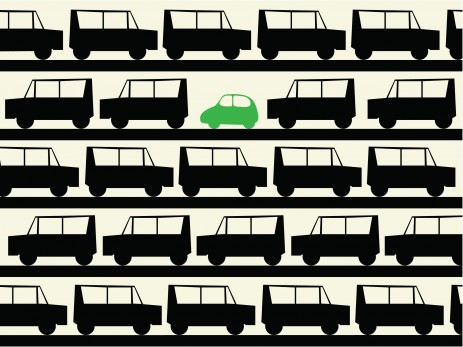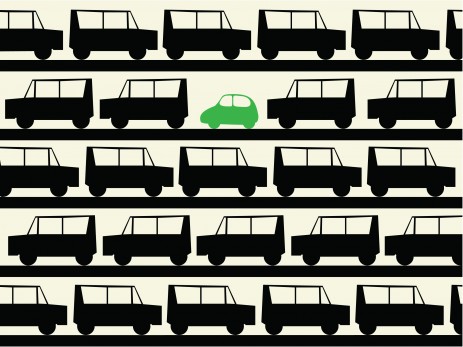 Ohio State University’s excellent Moving Ahead 2010 conference wrapped up with an impromptu panel on the oil spill and oil addiction. (White House energy adviser Carol Browner was supposed to do the final keynote, but got pulled away. Apparently there’s something going on in Louisiana.) I’ll wrap up my coverage by making a point I made on that panel, about a divide I noticed at the conference, and in the sustainable transportation world more broadly.
Ohio State University’s excellent Moving Ahead 2010 conference wrapped up with an impromptu panel on the oil spill and oil addiction. (White House energy adviser Carol Browner was supposed to do the final keynote, but got pulled away. Apparently there’s something going on in Louisiana.) I’ll wrap up my coverage by making a point I made on that panel, about a divide I noticed at the conference, and in the sustainable transportation world more broadly.
On one side, you have people like Scott Bernstein of the Center for Neighborhood Technology, Geoff Anderson of Smart Growth America, or Tom Murphy of the Urban Land Institute, who are focused on using land and urban assets more effectively, which means increasing density and walkability, which means driving less, which means fewer cars. That, in their mind, is what “sustainable transportation” means — it means more people walking or biking or taking public transit more often, and reducing the number and prevalence of personal vehicles.
On the other side you have people — many but not all of whom work at car companies — whose focus is on reducing the ecological impact of individual cars. Lots of these folks, as the conference made extremely clear, are smart as a whip and genuinely dedicated to the goal of sustainability. But the (often unspoken) assumption behind their work is that the car itself is the basic problem unit. People are going to keep driving like they do now; how can we make their cars cleaner?
You might think there’s no contradiction between these orientations. After all, it’s perfectly coherent to think we should reduce the amount of driving and also reduce the impact of the individual cars themselves.
But in practice there is some tension. Perhaps the most horrifying thing I heard at the conference was from Honda VP John Mendel, whose presentation was full of canned auto industry weaseling and dissembling. After reviewing all of the technological options Honda is pursuing, he said that the one they’re most committed to is fuel cells, because (paraphrasing from memory) “fuel cell cars most accurately replicate the characteristics of internal combustion engine cars.”
Is that really the extent of our ambition? To switch out the internal combustion engine for some other widget and otherwise keep on motoring as usual? To maintain the patterns of land use and development we have, simply with cars that emit less pollution? The poverty of that vision is tragic.
Now Honda guy would probably say, we have to build the cars consumers want, and what consumers want is big, powerful, long-range cars. They want the cars they have now, only less dirty. We respond to demand.
I don’t think this is particularly accurate even on its own terms. In virtually every city I’m familiar with, officials are attempting to revitalize downtown districts or create new, dense, walkable, mixed-use developments. They’re trying to create places where people don’t need to drive. Why? Because people love those places! Despite what car companies want you to believe, there’s no inherent human love of piloting military-sized vehicles through congested traffic.
On the other hand, though, I have some sympathy with automakers. They have to design for the world, and the policy regime, that actually exists. They can’t be in the business of betting on public policy that isn’t yet real. If it were a national goal to unwind sprawl, densify development, and build out inter- and intra-city public transit — if there were clear signals from national and local officials that America is heading in that direction — automakers might feel more confident designing cars that are suited to dense urban living. Instead of trying to replicate internal-combustion-engine cars, they might be designing cars that are small, lightweight, and intelligent. After all, most long-range trips would be handled by high-speed rail!
But automakers aren’t going to bet big on huge shifts in future policy. They won’t shift until lawmakers make it clear they have to.
This just demonstrates again the fallacy that sustainability is primarily about technology. Technology is a social practice; it shapes itself to, and co-evolves with, its social context. If we want real transportation sustainability, we have to have lawmakers, private industry, and citizens working in concert, singing from the same hymnal. We have to make the choice to be sustainable. We have to develop a shared vision of a sustainable future. Then, and only then, can industry respond with the technology that will get us there.



